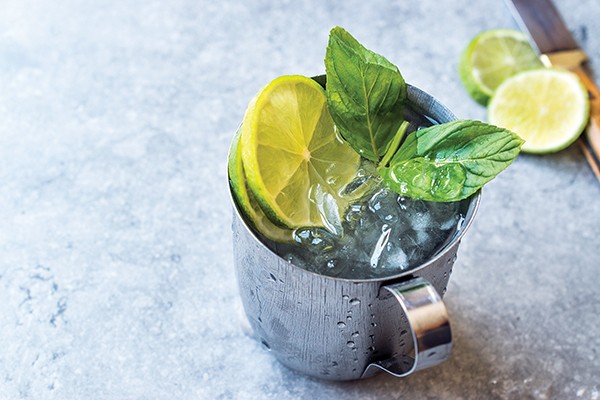A few weeks ago, I spent a Saturday afternoon perched on a stool at the long wooden bar at Café 1912. Friends and I watched the parade of thoroughbred horses lining up to run the 2018 Kentucky Derby, sipping on mint juleps that ace bartender Tyler Morgan prepared for us. Morgan plucked mint from a fresh, aromatic bouquet perched on the bar in honor of the occasion. He also made certain to use Woodford Reserve, the small-batch Kentucky bourbon brand that, these days, sponsors the $2 million-purse horse race won this year by a chestnut colt named Justify.
When I threw back my drink, the rich, syrupy flavor instantly reminded me of the very first time I tasted a mint julep. It must’ve been 25 years ago — sometime in the early-to-mid 1990s. The year might be hazy, but I remember exactly where I was when I tried it. Well, maybe not exactly — I was in a shotgun house that belonged to friends-of-friends in the Bywater neighborhood of New Orleans. We’d spent the evening at the Hi-Ho Lounge, then, when the bar closed, headed there instead of returning to my friends’ place in Gentilly. Someone had suggested juleps, and it seemed like a perfectly Southern thing to do. We had bourbon and sugar. Some of us wandered up the street to clip mint from a neighbor’s herb garden. Another of us mournfully noted the scant handful of ice cubes languishing in the freezer, and headed to the corner store for a fresh bag of ice. Our hostess stood at the stove, making simple syrup which had to chill before we could mix our drinks.
 Alp Aksoy | Dreamstime.com
Alp Aksoy | Dreamstime.com
I was tired, and the wait seemed interminable. I think the sun was coming up by the time we were finally able to toast each other with cups filled with macerated mint, simple syrup, bourbon, and crushed ice. It was worth the wait — and the cocktail’s loose affiliation with the sport of kings brought me luck the next afternoon, when, at the fairgrounds, I won nearly $100 on a $2 trifecta.
Mint juleps have been around since the mid-18th century, when they were prescribed as a remedy for stomach ailments, although the drink’s origins harken all the way back to the Middle East, where thirsty Arabs would order a julab, or rose-water drink.
The lions of the Southern literary canon — William Faulkner, Tennessee Williams, and Truman Capote — all wrote of their fondness for mint juleps. In Capote’s short story “The Bargain,” written in 1950, lost, and finally published in 2004, a character reminiscing about her ex-husband recalls how “we used to go down to the brook and pick mint and make mint juleps, huge ones in fruit jars.” Elsewhere, Capote wrote that “there is nothing better than a mint julep to bring relief from the pressures and pains of summertime.”
Mint juleps aren’t just for horse races. The drinks are as de rigueur as the Stella “shouting contest” at New Orleans’ annual Tennessee Williams Festival, held annually in late March. And at Rowan Oak, Faulkner’s Oxford, Mississippi, home, visitors can glimpse his battered metal julep cup, which is displayed in a glass case alongside an empty bottle of Four Roses bourbon. Yet the best — and most frequently cited — literature on the mint julep belongs to a Kentucky colonel-turned-newsman named Joshua Soule Smith, who penned an ode to the cocktail in 1890. In it, he described the bourbon and mint as “lovers” and declared reverently of the julep that “even the nectar of the Gods is tame beside it.”
With global climate change bringing sultry temperatures and stifling humidity levels to Memphis earlier every year, I’m tempted to escape into a mint julep fog by the end of May and not emerge again until mid-October. Served in a regular highball glass, the cocktail is coolly refreshing. Better yet, pour it into a traditional metal julep cup — I like the charm of used sterling silver cups found on ebay or at an antiques store, although you can easily purchase brand-new cups at Williams-Sonoma, Pottery Barn, or Crate and Barrel. Stick in the freezer for a bit after mixing your drink, so that the cup frosts and the bourbon blend turns into an icy slush. Give it at least 20 minutes — make dinner or take the dog for a walk in the interim.